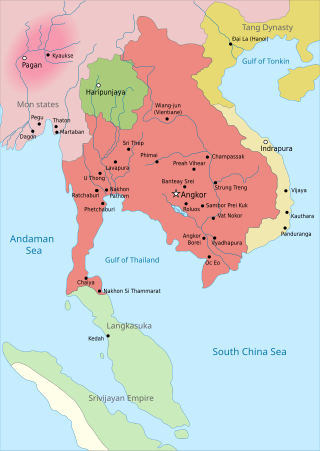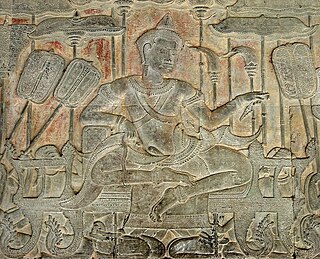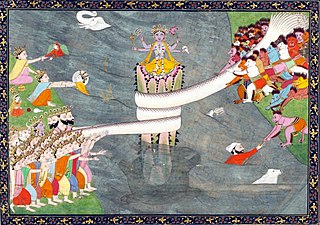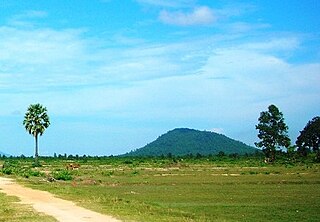
Khmer architecture, also known as Angkorian architecture, is the architecture produced by the Khmers during the Angkor period of the Khmer Empire from approximately the later half of the 8th century CE to the first half of the 15th century CE.
A solar equinox is a moment in time when the Sun crosses the Earth's equator, which is to say, appears directly above the equator, rather than north or south of the equator. On the day of the equinox, the Sun appears to rise "due east" and set "due west". This occurs twice each year, around 20 March and 23 September.

Angkor, also known as Yasodharapura, was the capital city of the Khmer Empire. The city and empire flourished from approximately the 9th to the 15th centuries. The city houses the Angkor Wat, one of Cambodia's most popular tourist attractions.

Angkor Wat is a Hindu-Buddhist temple complex in Cambodia, located on a site measuring 162.6 hectares. It resides within the ancient Khmer capital city of Angkor. Guinness World Records considers it as the largest religious structure in the world. Originally constructed as a Hindu temple dedicated to the god Vishnu for the Khmer Empire by King Suryavarman II during the 12th century, it was gradually transformed into a Buddhist temple towards the end of the century; as such, it is also described as a "Hindu-Buddhist" temple.

The Khmer Empire was a Hindu-Buddhist empire in Southeast Asia, centered around hydraulic cities in what is now northern Cambodia. Known as Kambuja by its inhabitants, it grew out of the former civilisation of Chenla and lasted from 802 to 1431. Historians call this period of Cambodian history the Angkor period, after the empire's most well-known capital, Angkor. The Khmer Empire ruled or vassalised most of mainland Southeast Asia and stretched as far north as southern China. At its peak, the Empire was larger than the Byzantine Empire, which existed around the same time.

Angkor Thom, alternatively Nokor Thom, located in present-day Cambodia, was the last and most enduring capital city of the Khmer Empire. It was established in the late twelfth century by King Jayavarman VII. It covers an area of 9 km², within which are located several monuments from earlier eras as well as those established by Jayavarman and his successors. At the centre of the city is Jayavarman's state temple, the Bayon, with the other major sites clustered around the Victory Square immediately to the north. The site is one of the major tourist attractions of Southeast Asia.

Suryavarman II, posthumously named Paramavishnuloka, was the ruler of the Khmer Empire from 1113 until his death in either 1145 or 1150. He is most famously known as the builder of Angkor Wat, the largest Hindu temple in the world, which he dedicated to Vishnu. His reign's monumental architecture, numerous military campaigns and restoration of strong government have led historians to rank Suryavarman II as one of the empire's greatest rulers.

The March equinox or northward equinox is the equinox on the Earth when the subsolar point appears to leave the Southern Hemisphere and cross the celestial equator, heading northward as seen from Earth. The March equinox is known as the vernal equinox in the Northern Hemisphere and as the autumnal equinox in the Southern Hemisphere.

Suryavarman I was king of the Khmer Empire from 1006 to 1050. Suryavarman usurped King Udayadityavarman I, defeating his armies in approximately 1002. After a protracted war with Udayadityavarman's would-be successor, Jayavirahvarman, Suryavarman I claimed the throne in 1010. Suryavarman was a Mahayana Buddhist who was also tolerant of the growing Theravada Buddhist presence in the Khmer kingdom.

Banteay Samré is a temple at Angkor, Cambodia, located 400 metres to the east of the East Baray. Built during the reign of Suryavarman II and Yasovarman II in the early 12th century, it is a Hindu temple in the Angkor Wat style.

Beng Mealea, or Boeng Mealea, is a temple from the Angkor Wat period located 40 km (25 mi) east of the main group of temples at Angkor, Cambodia, on the ancient royal highway to Preah Khan Kompong Svay.

Mandara is the name of the mountain that appears in the Samudra Manthana episode in the Hindu Puranas, where it was used as a churning rod to churn the ocean of milk. Shiva's serpent, Vasuki, offered to serve as the rope pulled on one side by a team of asuras, and on the other, by a team of devas. The Puranas refer to various sacred places on the hill that are also believed to be the abode of the avatar Krishna as Madhusudana or the destroyer of the asura called Madhu, who was killed by Krishna and then covered by the Mount Mandara.

Manhattanhenge, also called the Manhattan Solstice, is an event during which the setting sun or the rising sun is aligned with the east–west streets of the main street grid of Manhattan, New York City. The astrophysicist Neil deGrasse Tyson claims to have coined the term, by analogy with Stonehenge. The sunsets and sunrises each align twice a year, on dates evenly spaced around the summer solstice and winter solstice. The sunset alignments occur around May 28 and July 13. The sunrise alignments occur around December 5 and January 8.

Phnom Bok is a hill in the northeast of Eastern Baray in Cambodia, with a prasat (temple) of the same name built on it. It is one of the "trilogies of mountains", each of which has a temple with similar layout. The creation of the temple is credited to the reign of Yasovarman I (889–910) between 9th and 10th centuries; established after he moved his capital to Angkor and named it Yasodharapura. The two other sister temples, named after the contiguous hills, are the Phnom Bakheng and Phnom Krom.
Kbach or Khmer ornamentation is made of traditional decorative elements of Cambodian architecture. While 'kbach' may refer to any sort of art-form style in the Khmer language, such as a gesture in Khmer classical dance, kbach rachana specifically refers to decorative ornament motifs. Kbach are also used in decorating of Cambodian silver crafts, furniture, regalia, murals, pottery, ceramics, stone carving, in a singular artistic expression:
the exceptional advantage that the Khmers have drawn from nature and the human experience as the universal framework of any aesthetic experience has contributed to rendering in the kbach one of the most remarkable traits of human genius, that of artistic expression.
A Dharmasala or a house of fire, or house with fire, is the name given to a place where people, especially pilgrims, can rest on a journey. It is a type of building found in Angkorian complexes constructed during the reign of late 12th-century monarch Jayavarman VII and still found in Preah Khan, Ta Prohm and Banteay Chhmar.
The fall of Angkor, also known as the sack of Angkor or siege of Angkor, was a seven-month siege of the Khmer capital Angkor by the Ayutthaya Kingdom. After the Khmer refused to recognize Ayutthaya authority, the Ayutthaya besieged Angkor and sacked the capital city. The Khmer King Ponhea Yat fled the city to Basan and later to Chaktomuk . Though the Khmer Empire was already in decline, the conquest of Angkor delivered the final blow and the empire fell. Angkor was subsequently abandoned. After the Fall of Angkor, the king moved the capital first to Basan and later to Chaktomuk, initiating the period known as the Post-Angkor period.

The Battle of Tonlé Sap took place between Champa and the Khmer Empire in 1177.
The Poem of Angkor Wat, is a Khmer poem which dates from the beginning of the 17th century. It celebrates Angkor Wat, the magnificent temple complex at Angkor and describes the bas-reliefs in the temple galleries that portray the Reamker. The Poem of Angkor Wat is considered to be the earliest original literary work in Khmer language. It is one of the two great epic poems of Cambodia with the Reamker in the style of the Indian epic poetry.














